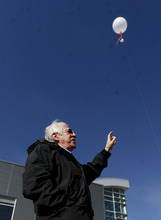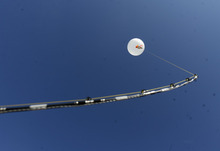This is an archived article that was published on sltrib.com in 2012, and information in the article may be outdated. It is provided only for personal research purposes and may not be reprinted.
Vernal • A big science project is under way this winter to understand why ozone builds up in eastern Utah's Uinta Basin on snowy winter days.
Tammie Lucero, director of the Uintah County Economic Development Office, said industry and the community have a lot on the line with the $5.5 million program to understand the basin's unusual pollution problem.
"Everybody here wants clean air," she said. "That being said, economic development is important in Uintah County."
A news conference Tuesday kicked off a public information day in Vernal so locals could find out more about the $5.5 million study.
Residents have been invited to a community open house Tuesday evening at the Bingham Research Center, a high-tech energy and general education hub affiliated with Utah State University.
Residents already are seeing the benefits of the attention being paid to the basin's peculiar air-quality problems. In the fall, the Utah Division of Air Quality began offering air-quality alerts online, providing the same kinds of pollution forecasts for basin residents as it does for the state's urban centers.
Meanwhile, the researchers have been probing the mystery of why ozone rises so high and so often in winter in the sparsely populated basin, when ground-level ozone is typically a problem in the summer in big cities such as Los Angeles.
They want to know the chemical reactions that make ozone build up. They want to know what role weather plays. They want to understand how much is drifting into the basin from other cities and even other continents.
National Oceanic and Atmospheric Administration researcher Gabrielle Petron noted that this year's weather, which has left the basin without the ozone-boosting snow cover, will not provide some of the data that would be helpful to understand what happens in snowy years.
"NOAA is interested in getting as much information as we can," she said, standing outside an instrument-loaded van that she steers around the basin most of the day and night. "It's exciting."
Ozone in the upper layers of the atmosphere serves as a protective layer, but close to the ground it causes what is sometimes described as a sunburn on the lungs. Because of health impacts, people who live where ozone is high are urged to limit their outdoor activities and to limit exertion.
While the most obvious health danger is to sensitive groups, like the young, the old and people with heart and lung trouble, healthy people are at risk, too.
That's why air-quality officials were surprised and concerned when monitoring in Uintah and Duchesne counties the past two winters generated some of the nation's highest ozone measurements.
No one would have expected it, since with just 30,000 residents, the basin is considered too rural to check for pollution by federal standards. But USU's Energy Dynamics Laboratory found last year that ozone pollution shot up during inversions when there was snow on the ground.
Under the U.S. Environmental Protection Agency's health-based standards, ozone concentrations of 75 parts per billion or more are considered unhealthy. At one Uinta Basin monitoring site, in Ouray, the concentration measured 149 parts per billion. At Ouray and at Horse Pool, the highest readings exceeded EPA's standard on 25 days.
But there is reason to suspect that emissions from the basin's 15,000 oil and gas wells are big pieces of the puzzle. The phenomenon is already being addressed in the oil and gas fields of Wyoming and Colorado.
There are high hopes that the Uinta Basin study will break new ground and find new solutions to a problem that has enormous implications for the region's booming energy industry.
Bryce Bird, director of the Utah Division of Air Quality, said the collaborative approach is key to puzzling through the problem — as his agency, industry and Utah Gov. Gary Herbert are determined to do.
"It's important to find local solutions to local problems," Bird said. "This approach should be modeled across the country."
If the pollution isn't addressed, energy development could be slowed. The EPA, which is part of this year's study, warned the state in December that pollution controls could be mandated as early as next year.
Besides the EPA, the state and NOAA, the research team includes, the Energy Dynamics Lab, the University of Colorado, the U.S. Bureau of Land Management, the Uintah Impact Mitigation Special Service District and the Western Energy Alliance.
The alliance, a trade group for the oil and gas industry whose members have around 15,000 oil and gas wells in Uintah and Duchesne counties, is kicking in more than $1 million cash for the studies, said Kathleen Sgamma, the group's director of government and public affairs.
"Western Energy Alliance member companies have been studying air quality and taking measures to reduce air emissions in the Uinta Basin for years," she said in a news release. "Industry is serious about protecting air quality while continuing to develop domestic energy in the West, and proud to be a part of this vital study for advancing the scientific understanding of wintertime ozone."
Twitter: @judyfutah —
Who's paying for the study?
The total cost of studying pollution in Utah's oil and gas region is nearly $5.5 million. The National Oceanic and Atmospheric Administration is chipping in nearly $2 million. The Western Energy Alliance has promised $1.125 million. The state Department of Environmental Quality is chipping in $522,000, the Environmental Protection Agency is providing $100,000, the U.S. Bureau of Land Management is contributing $122,000 and the Uintah Impact Mitigation Special Service District has pledged $1.38 million.







